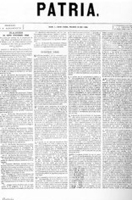3.8.3 José Martí’s journalistic work in New York (1880-1892)

José Martí’s most prolific period as a journalist was in New York, where he arrived in 1880. There, he contributed to the art magazine “The Hour” and the newspaper “The Sun,” demonstrating his mastery of a variety of artistic and literary subjects. In 1881, after a brief stay in Venezuela, where he edited the “Revista Venezolana,” he returned to the United States as a correspondent for the newspaper “La Opinión Nacional.”
In 1889, Martí devoted himself to a particularly satisfying endeavor: writing for the children’s magazine “La Edad de Oro.” The magazine, published monthly, ran only from July to October. The Maestro’s writings are strongly anti-colonialist, anti-imperialist, and pro-American, seeking to instill in children a love for the great homeland that is all of America, as well as feelings of justice, honesty, and appreciation for the things that make up their environment. These stories include “The Black Doll,” “The Three Heroes,” “Homer’s Iliad,” “The Story of Man Told by His Houses,” “Rosa’s Little Shoes,” and others.
On March 14, 1892, the newspaper “Patria” was born, the voice of Cuban and Puerto Rican emigrants in the United States, to report on the preparations for the independence struggle that was being organized, as well as a means of ideological propaganda to unite as many people as possible to the cause.
Martí’s journalism evolved into a new genre: the modernist chronicle. With his own distinctive style, his articles were written in the form of letters. Each time he wrote, he offered a master class on what an honest journalist should be, consistent with his ideas and the times in which he lived: “The press cannot be, in these times of creation, a mere vehicle for news, nor a mere servant of interests, nor a mere outlet for the exuberant and lush imagination. The press is Vinci and Angelo, creator of the new, great and invisible temple, of which the pure and hardworking man is the brave priest. Here, alongside modern human problems, the concrete problems of America simmer, along with alarming ambitions and dazzling real grandeurs. How much more, moved by the desire to fulfill these great duties, the pen, at the risk of seeming tired, abandons itself to considering them?”
Among Martí’s journalistic writings, the most significant are “Vindication of Cuba,” an open letter written in 1889 to The Evening Post in response to an article published in The Manufacturer, a Philadelphia newspaper, scathingly attacking Cubans during the debate over the island’s acquisition by the United States. The essay “Our America,” published in the Mexican newspaper “El Partido Liberal” in January 1891, defending the right of Cubans and Latin Americans to fight for independence, is particularly significant. This was one of his last contributions before devoting himself entirely, from the middle of that year, to the final phase of his revolutionary work.








